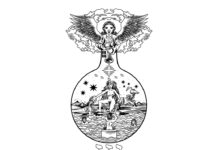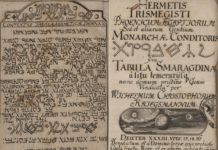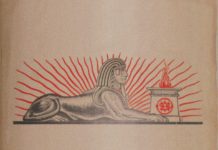This article is an exiciting new blog contribution from the Sodalitas Rosae+Crucis & Solis Alati (SRC&SSA) in joint partnership with Pansophers.com for the beehive project.
Sodalitas Rosae+Crucis & Solis Alati (SRC&SSA) is a magical, mystical and alchemical Order, manifested in the fall of 2002 A.D., and publicly opened at the spring equinox 2003. Our intention is to bring together some of the main esoteric streams and movements within the western hermetic tradition, under the apophthegm of the Rosicrucian ideal, as stated in the Fama and Confessio: a brotherhood, working in secrecy, focused on a sincere inner development of its members, thereby affecting the world at large, without any interest of financial gain.
The name, Sodalitas Rosae+Crucis & Solis Alati, is in fact the name of two Orders. The first, Sodalitas Rosae+Crucis (S.R.C.), translates into “The Secret Society of the Rosy Cross”, thus representing the Rosicrucian flavour of the magical and mystical processes that lead the candidate to a full contact with his/her Holy Guardian Angel. The second, Sodalitas Solis Alati (S.S.A.), which translates into “The Secret Society of the Winged Sun”, indicates the alchemical work that the adept is then ready for. Within these two Orders, the magical work and initiations of the Golden Dawn, Alpha & Omega and Rosae Rubeae et Aurea Crucis, the mystical work and initiations of Christian Theurgy and the alchemical work of the Royal Path integrates into a coherent system of personal unfoldment and development, where every step follows the next in a clear and consistent way.
The purpose of the Order is the perpetuation and realization of the western hermetic tradition in this new era. Our work is to bring forth the Light of our predecessors, our Mothers and Fathers in Gnosis, Who have perpetuated Truth through the traditions of the Rosicrucian Order, the Primitive Rites of the Egyptians, the Royal Art of the Alchemists, The Concealed Mysteries of the Kabbalists & the Gnosis of our beloved Lady Sofia.
To understand the legacy that our Order seeks to perpetuate and develop, it is useful to have some basic knowledge of the different main currents and societies that have influenced the Order, directly and indirectly. The present article intends to paint a brief overall picture of this.
In our by-laws and on our website, we openly state our influence from the Rosicrucian manifestos of early 17th century. And while this article could have easily started there, I intend to jump forward one century, because it is from that period that we can trace not only “inspired” lineage but also “factual” lineage, and our great heritage from our European predecessors.
Throughout the 18th century, secret orders, mysticism, magic and alchemy flourished in Europe. There were of course many connections to the 17th century, but what foremost distinguished the 18th century were the many well-organized societies that emerged, and which quickly spread to other countries. They had in common that they presented coherent systems and initiation rites, with the purpose of achieving direct knowledge of mankind, nature and the divine in what we now term the western Rosicrucian or hermetic tradition. Some sought to establish their own systems on top of the three recognized degrees of freemasonry (the so-called blue degrees or craft that were already established by then). They were thus called freemasonic high degree systems (red degrees) and were without a doubt the societies that succeeded most in becoming widespread. There were, however, also other societies that chose to work outside freemasonry, and some that did both.
Among the most important societies, we must mention the German based orders of Strict Observance, Gold und Rosenkreutz and Asiatic Brethren which had in common that they all were, in different ways, established in Sweden as a result of the great esoteric interest of the Swedish duke Charles (later King Charles XIII), the French orders of Elus Coën and Chevaliers Bienfaisants de la Cité Sainte, and the Italian orders of Memphis and Misraïm. But with the exception that they were all built upon freemasonry, and thus were classified as high degree systems, their contents differed considerably.
Der Stricten Observanz
Strict Observance (SO) claimed a linear succession to the old Templars, and sought to reform freemasonry and replace some of its various esoteric connections with a strict discipline and functionality (which, however, also included laboratory alchemy in the higher degrees). After the death of its leader, Baron von Hund, duke Charles (later King Charles XIII) of Sweden was meant to become its international leader, and then, as the leader of European Freemasonry, reform the system (which he later did in the Swedish masonic rite). However, the Duke resigned as its leader after less than 2 years, due to a strong resistance from high-grade members in both Denmark and Germany (Sweden and Denmark were not on very good terms back then), and the rite thus never merged with the Swedish masonic rite. His brother, King Gustaf III, was initiated into the Royal and Noble Order of the Thistle (also called the Order of St Andrew) by the “Pretender”, the Jacobite Charles Stuart II (who laid claim on the English throne), and installed as his successor, as Grand Master of the Holy Order of our Lord Jesus Christ’s Temple on the 8th of December 1783, whereupon the lineage and plenty written material was brought to Sweden. Also Baron von Hund, the founder or re-establisher of the Strict Observance, was initiated into the Order of the Thistle by Christophe de Bonneville, possible as a way of strengthening its connection with the Templar order. This claim, rather ironically, together with the belief in secret chiefs that would come and provide the order with the “real” esoteric teachings, brought the order to an end in 1782 (see CBCS – in 1777, Willermoz was chosen to reform the system).
Des Ordens der Rosen- und Golden-Creutzer
Gold und Rosencreutz (GuR), which claimed a direct or indirect linear succession to the Rosicrucian groups of the 16th century, highlighted the role and importance of alchemy and sought to (re)establish the society that the Rosicrucian manifestos described. In their 1767 reformation they established the titles and order of the 9 Rosicrucian grades, which have since then been utilized by many RC groups. The purpose of the Order was to regenerate man back to his original dignity, learn the secrets of nature, and restore the image of God. The members had to study and work diligently with laboratory alchemy, before the magical and theurgical work was allowed to commence in the higher grades. In the 9th degree, that of Magus, the secrets of life and death were conveyed, which in theory should enable the creation of life and the overcoming of death. They believed, like SO, in secret chiefs that would eventually come and provide the most sublime alchemical and theurgical secrets. At least a couple of high-ranking lodge masters were deceived by people claiming to be such secret chiefs. Swedish King Gustaf III applied for initiation and the order had several Swedish members. In Sweden there also existed an independent religious current which gave three apostolic ordinations in a Rosicrucian context, called Theosophia Apostolica Rosæ Crucæ, where the focus was to establish a clear contact with one’s Holy Guardian Angel.
Den Ritter und Brüder St. Johann des Evangelisten aus Asien in Europa
The Asiatic Brethren (AB – The Brethren of St John the Evangelist from Asia in Europe), which initially was formed from the Gold und Rosencreutz order, claimed direct or indirect linear succession to the seven churches of St John in Asia and the esoteric roots of Christianity. They emphasized the role and importance of magic, but worked also with inner alchemy (officially they rejected outer or laboratory alchemy, but at least some members held another view) and Kabbalah (in contrast with many other societies, they actually had a Jewish kabbalist writing their kabbalistic lessons). They differed prominently from other societies by not requiring Christian faith of its members.
It was introduced in Sweden by Duke Charles in the 1780’s who had received a temple charter and their secret material so as to establish a temple and translate its doctrines, but eventually he chose to focus on his Solomonic magical work instead. Later on the royal court secretary C A Boehman re-introduced it in the 1790’s; the order was then, however, already in decline due to the war between them and GuR (they both sought to expose the other group as a hoax controlled by the Jesuits, when they were not both fighting Weishaupt’s Illuminati). Instead, Boehman started to work extensively together with Prince Hessen and Duke Charles to establish a masonic-magical society called DELU, which in effect became the successor of AB. Their headquarters was in Denmark, and prince Carl of Hessen was its Danish leader. This society was, in contrast to the others here mentioned, open for both men and women, with initiation rituals based on inner alchemy, Christian theosophy and Christian kabbalah. The work in Sweden got an abrupt ending when Boehman was deported in 1803, accused of espionage for the Illuminati against the Swedish King, in what can only be described as a great conspiracy constructed by the Swedish secret police. The order carried on in Denmark, Germany, Italy and England.
The above-mentioned societies generally ceased their activities, both in Sweden and in Europe, between 1790 and 1830. The currents flourished again at the end of the 19th century, foremost in England and in France, but let us first consider the French and Italian movements.
Ordens des Chevalier Macons Elus-Coën de L’Univers
Elus Coën (EC) or the Elected Priests was founded by Martinez de Pasqually and operated a practical theurgical system, including prayers, invocations, evocations and exorcisms, with the aim of universal reintegration. It was early recognized as a valid freemasonic high degree system by the French grand lodge and opened several lodges, but did not spread outside the borders of France. After Pasqually’s death the order started to suffer from a lack of leadership, and one of its sincere members, as well as Pasqually’s personal friend, Jean-Baptiste Willermoz, decided to implant its esoteric teaching in Chevaliers Bienfaisants de la Cité Sainte (CBCS) – “Knights Beneficent of the Holy City” – which was absorbed into the Rectified Scottish Rite. This order became the direct successor of the Strict Observance in 1782, and thus carried on the legacy of Elus Coën but without its practical operations. EC did not really resume any work after the French revolution, whereas CBCS continued in Switzerland. Both orders were re-activated in France in the mid-20th century. Another member of the EC, Louis Claude de St Martin, continued its teaching in what later became known as the way of the heart (where the other strong influence was the German mystic Jacob Böhme), and although he never created any order there exists today countless societies paying homage to him in what is now known as the Martinist tradition.
Misraïm, Memphis and the Arcana Arcanorum
The rites of Misraïm and Memphis, commonly known as Egyptian freemasonry, originated in Italy and combined masonic symbolism with Egyptian and alchemical references. Cagliostro introduced the three very secret and famous degrees of Arcana Arcanorum (AA) into the rite of Misraïm in 1788, out of which the rite of Memphis later manifested (1838), which also incorporated templar and chivalry symbolism. The rites merged into Memphis-Misraïm (MM) in the late 19th century, and are unrivalled when it comes to quantity of degrees in one system. Several versions of the AA have existed and been in use, and since many consider it to be the one real golden treasure of the hermetic tradition, no MM society dare to give any details about it (some however have dared to make up their own versions, so that they officially can claim to possess it). The Grand Sanctuary Adriatic (GSA) of MM was founded by Marco Edigio Allegri in 1945, which incorporated martinist and apostolic currents into the rite.
Fratellanza Terapeutica Magica di Myriam
The Therapeutic and Magic Fraternity of Myriam (Fr+ T+ M+ di Myr) was constituted by Kremmerz in 1896, as a restoration of a magical and spiritual Fraternity on the model of the former Isis and Osiris currents of Egypt. It claimed to be a direct successor of the mediaeval Italian Brotherhood of Red Monks and the Neapolitan tradition of the Order of Osiris (and thus a legitime AA current). Through lessons, initiations and practical instructions, the way of Hermetic Science and healing was taught, which included rituals, prayers, talismanic magic, therapeutic presence and internal alchemy, focused upon the four bodies of man: the Saturn body, the Lunar body, the Mercurial body, and the Solar body.
The Hermetic Society of the Golden Dawn and the Rosae Rubea et Aurea Crucis
Golden Dawn (GD) with its inner order Rosae Rubea et Aurea Crucis (RR&AC) was created in England in 1888 and 1892 by Woodman, Westcott and Mathers, and are by many considered to be the most influential magical society within the Anglo-Saxon Hermetic tradition, with elaborate initiation rites and practical magical work. Some have claimed it be a direct succession of the AB and indirect of the GuR; however, there exists no similarity between the theoretical and practical material of AB and GuR with that of RR&AC. RR&AC highlighted magic as the working tool, supported by tarot, kabbalah, Enochian magic, astrology, geomancy and Egyptian mythology in a beautifully synchronized manner. The order was open for both men and women and today several societies claim direct or indirect succession to it through one of its successors (mainly Alpha et Omega, Holy Order of the GD and Stella Matutina). Through the works of its 20th century adepts, it has also embraced depth psychology as an important aspect of the magical and mystical work.
Several societies were created in France during the same time, which worked with kabbala and the hermetic tradition, for example Ordre Kabbalistique de la Rose+Croix (OKRC), and martinists organized themselves in Ordre Martiniste (OM) with Papus as their leader. France had in many ways a “richer” heritage to pour from than England, since EC had survived through CBCS, and EASIA-EASIE, Rose-Croix d’Orient and FAR+C conveyed the heritage of the earlier Rosicrucian’s, and the different rites of Memphis-Misraïm offered a continuation in the Egyptian masonry. Further, the foundation of the modern Gnostic movement took place when Jules Doinels created L’Eglise Gnostique Universelle Catholique. One should therefore not underestimate the French importance within the hermetic tradition, even if we today who are more familiar with English than French, German, Italian and Swedish often are enticed to believe that the Anglo-Saxon world has been behind everything of importance.
All these named societies and traditions have two things in common; a) they have, to a greater or lesser extent, preserved and perpetuated the western Hermetic tradition, and b) they have all been involved in mud-slinging campaigns against fellow brethren/groups. The former we draw our inspiration from, seeking to continue their exalted work; the latter we strive to be conscious about, so that history does not have to repeat itself again and again.
Licht, Liebe und Leben!
L.V.X
Fra. A.V.I.A.F.










